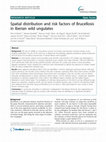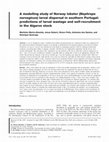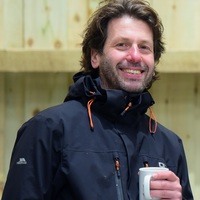Papers by Alvaro Jesus Portugal
Revue De Medecine Interne, 1993
Continental Shelf Research, 2009
... Author Contact Information , E-mail The Corresponding Author , Rita Nolasco b , Jesus Dubert ... more ... Author Contact Information , E-mail The Corresponding Author , Rita Nolasco b , Jesus Dubert b , Teresa Moita a and Álvaro Peliz c. ... The SST and [Chl] concentration maps derived from MODIS data (Feldman and McClain, 2006) were obtained from the Goddard's Space Flight ...

BMC Infectious Diseases, 2010
Background: The role of wildlife as a brucellosis reservoir for humans and domestic livestock rem... more Background: The role of wildlife as a brucellosis reservoir for humans and domestic livestock remains to be properly established. The aim of this work was to determine the aetiology, apparent prevalence, spatial distribution and risk factors for brucellosis transmission in several Iberian wild ungulates. Methods: A multi-species indirect immunosorbent assay (iELISA) using Brucella S-LPS antigen was developed. In several regions having brucellosis in livestock, individual serum samples were taken between 1999 and 2009 from 2,579 wild bovids, 6,448 wild cervids and4,454 Eurasian wild boar (Sus scrofa), and tested to assess brucellosis apparent prevalence. Strains isolated from wild boar were characterized to identify the presence of markers shared with the strains isolated from domestic pigs. Results: Mean apparent prevalence below 0.5% was identified in chamois (Rupicapra pyrenaica), Iberian wild goat (Capra pyrenaica), and red deer (Cervus elaphus). Roe deer (Capreolus capreolus), fallow deer (Dama dama), mouflon (Ovis aries) and Barbary sheep (Ammotragus lervia) tested were seronegative. Only one red deer and one Iberian wild goat resulted positive in culture, isolating B. abortus biovar 1 and B. melitensis biovar 1, respectively. Apparent prevalence in wild boar ranged from 25% to 46% in the different regions studied, with the highest figures detected in South-Central Spain. The probability of wild boar being positive in the iELISA was also affected by age, age-by-sex interaction, sampling month, and the density of outdoor domestic pigs. A total of 104 bacterial isolates were obtained from wild boar, being all identified as B. suis biovar 2. DNA polymorphisms were similar to those found in domestic pigs. Conclusions: In conclusion, brucellosis in wild boar is widespread in the Iberian Peninsula, thus representing an important threat for domestic pigs. By contrast, wild ruminants were not identified as a significant brucellosis reservoir for livestock.

Canadian Journal of Fisheries and Aquatic Sciences, 2008
A set of simulations using a validated and realistic parameterization of a numerical model was co... more A set of simulations using a validated and realistic parameterization of a numerical model was conducted for the south and southwest Portuguese regions as an attempt to understand larval dispersal patterns in the Norway lobster (Nephrops norvegicus). Larvae were introduced in the model as Lagrangian particles with five different behavioural scenarios concerning their ability to migrate vertically. Growth rate was temperature dependent and the larvae were tracked individually. The end point of the simulations was the position of the larvae when they reached competency at age 1. Age 1.25 was also considered to simulate a possible delay in settling due to lack of an appropriate substrate. The results showed that the majority of the larvae reached age 1 near the hatching area along the southern shelf, while low exchange of larvae between the south and the west coasts was observed, especially for behavioural scenarios where larvae remained in relatively shallow waters. Scenarios where larvae performed diurnal vertical migration and delayed settlement until age 1.25 indicated a tendency for westward motion because of interactions with the Mediterranean undercurrent. Self-recruitment to the Algarve stock was estimated at 0.2% to 0.5%, raising the concern that this stock may be experiencing recruitment limitation.










Uploads
Papers by Alvaro Jesus Portugal